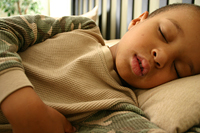Let us sleep to greater education
Imagine if in the future, your students could improve their alertness during the afternoon by 50%. I am pretty sure that could help you in your teaching, not to mention what it would do for your students’ performance.
 NASA did a well-cited study that suggests that you can increase performance by up to 34% and alertness by up to 54%, if you take a 26 minute nap during the day. The study was done in another environment with adults, but I think that it says something about the future possibilities of performance related to taking a nap.
NASA did a well-cited study that suggests that you can increase performance by up to 34% and alertness by up to 54%, if you take a 26 minute nap during the day. The study was done in another environment with adults, but I think that it says something about the future possibilities of performance related to taking a nap.
We can easily adjust the school day to include 30 minutes for a nap after lunch, if it means improvement in education. I wouldn’t mind having my kids come home 30 minutes later each day if they have been given a better chance to absorb their learning (not only because of their own nap, but also their peers).
 NASA did a well-cited study that suggests that you can increase performance by up to 34% and alertness by up to 54%, if you take a 26 minute nap during the day. The study was done in another environment with adults, but I think that it says something about the future possibilities of performance related to taking a nap.
NASA did a well-cited study that suggests that you can increase performance by up to 34% and alertness by up to 54%, if you take a 26 minute nap during the day. The study was done in another environment with adults, but I think that it says something about the future possibilities of performance related to taking a nap.
We can easily adjust the school day to include 30 minutes for a nap after lunch, if it means improvement in education. I wouldn’t mind having my kids come home 30 minutes later each day if they have been given a better chance to absorb their learning (not only because of their own nap, but also their peers).
Taking a nap has a bad ring to it, mostly because it is not accepted to take a nap at work or school. But, what if tomorrow your employer ordered all employees to take a 30 minute nap every day; wouldn’t that make all the difference?
As usual, if we get students to adopt something from an early age it would not be a problem to maintain it. It might be difficult for you to suggest that your 14 year old students should take a nap tomorrow when they go to school, but if you ask the kindergarten that supplies your school not to stop with their naps then it will be no problem for your first graders to adopt the idea of taking a nap when they start with you.
The best time to take a nap is between 1-3 pm, so either your students can take a nap directly after lunch or a bit later in the afternoon. Just clear the room of desks (if you still have any), close the blinds and have the students bring out their mattresses and take their nap. Jennifer Ackerman has made a good summary of what to think of when taking a nap.
A nap for better alertness will, most likely, also decrease the consumption of substances to try to stay alert, like coffee, energy drinks, etc. If we are lucky, a side effect of the naps would be healthier living since it is said to reduce stress and lower the risk of weight gain, diabetes, stroke and heart attack (a major study completed with adults from Greece shows that there is 64% less risk of dying of heart disease if you take naps three times a week).
Do you have any experience with your students taking a nap after lunch? Do you know of any research that has been made regarding students taking a nap while in school? What would be really interesting is a study that takes into account the information overload that most students nowadays are dealing with. How is the digestion and learning of this information affected by taking regular naps?
So, if your school board is considering investing in expensive technical equipment for your students to get a better education, make sure they have bought the students mattresses and pillows first…




 November 19, 2040 - Today was a historic day for Iceland when their President this morning at a symbolic ceremony officially shut down the last gasoline pump in the country. Iceland is a model country when it comes to the fuel transition from gasoline to hydrogen and became today the first country in the world to complete it.
November 19, 2040 - Today was a historic day for Iceland when their President this morning at a symbolic ceremony officially shut down the last gasoline pump in the country. Iceland is a model country when it comes to the fuel transition from gasoline to hydrogen and became today the first country in the world to complete it.

 September 21, 2050 - At a press conference today it was announced that the first tourist heading for Mars will be the 38-year-old US businessman Patrick Clifford. He will leave the earth in the launching window of June 2052 and set his foot on the surface of Mars in November, together with the other 6 astronauts assigned for the mission to further explore the planet.
September 21, 2050 - At a press conference today it was announced that the first tourist heading for Mars will be the 38-year-old US businessman Patrick Clifford. He will leave the earth in the launching window of June 2052 and set his foot on the surface of Mars in November, together with the other 6 astronauts assigned for the mission to further explore the planet.
 September 12, 2035 - Are you kidding? Is it possible to beam myself? No, of course not, but you can now make a 3-D projection of yourself anywhere in the world. The first product for real teleimmersion has been released, the Telebeamer.
September 12, 2035 - Are you kidding? Is it possible to beam myself? No, of course not, but you can now make a 3-D projection of yourself anywhere in the world. The first product for real teleimmersion has been released, the Telebeamer. September 5, 2035 - More than 20,000 quadriplegics around the world have now got a BCI, a Brain Computer Interface. It gives them the ability to control their environment, from driving their own electric wheelchairs outside their house, to make their own dinner.
September 5, 2035 - More than 20,000 quadriplegics around the world have now got a BCI, a Brain Computer Interface. It gives them the ability to control their environment, from driving their own electric wheelchairs outside their house, to make their own dinner.
 September 1, 2040 - From today you have your own therapist available 24 hours a day, always there if you need someone to talk to, always in a good mood, and remembers every word you have ever said. This is the first automated therapist, with the best knowledge known to mankind on treatment and rehabilitation.
September 1, 2040 - From today you have your own therapist available 24 hours a day, always there if you need someone to talk to, always in a good mood, and remembers every word you have ever said. This is the first automated therapist, with the best knowledge known to mankind on treatment and rehabilitation.  August 24, 2020 - The first full-length animated movie with realistic-looking humans, "Tickle" opens tonight. It is an intriguing thriller about a woman who gets framed by her husband, but the most intriguing is to see if you can spot the difference between real actors and these created by computers.
August 24, 2020 - The first full-length animated movie with realistic-looking humans, "Tickle" opens tonight. It is an intriguing thriller about a woman who gets framed by her husband, but the most intriguing is to see if you can spot the difference between real actors and these created by computers.
 August 23, 2025 - Today a new chapter in space tourism was written. Rod Markham and his wife-to-be Susan Millster arrived safely to the moon to spend 5 days as the first guests at the Starbright Hotel that was set up for this purpose two years ago.
August 23, 2025 - Today a new chapter in space tourism was written. Rod Markham and his wife-to-be Susan Millster arrived safely to the moon to spend 5 days as the first guests at the Starbright Hotel that was set up for this purpose two years ago.
 August 16, 2020 - For the first time a court case is based on a multi voice recognition transcript as the main evidence. It was when Frank Levin took part in a dispute with four people that resulted in a fired gun that killed Adam Denny. The three other all testified that Frank had pulled the trigger, while Frank claims that according to the transcript, it clearly states that he was not the one holding the gun.
August 16, 2020 - For the first time a court case is based on a multi voice recognition transcript as the main evidence. It was when Frank Levin took part in a dispute with four people that resulted in a fired gun that killed Adam Denny. The three other all testified that Frank had pulled the trigger, while Frank claims that according to the transcript, it clearly states that he was not the one holding the gun.
 June 6, 2040 - For the first time ever, in-atmosphere passenger kilometers have passed 8,000 billion per year worldwide, according to the latest statistics, which is an increase by three times during the last 30 years. The introduction of the super-jumbo (600-seat airliners) combined with the low price level for flight traveling has kept the numbers steadily increasing.
June 6, 2040 - For the first time ever, in-atmosphere passenger kilometers have passed 8,000 billion per year worldwide, according to the latest statistics, which is an increase by three times during the last 30 years. The introduction of the super-jumbo (600-seat airliners) combined with the low price level for flight traveling has kept the numbers steadily increasing.
